| |
 Network
Video Solution Network
Video Solution
DVR2460
Network Digital Video Recorder
Digital video. Recorded
locally. Viewed globally.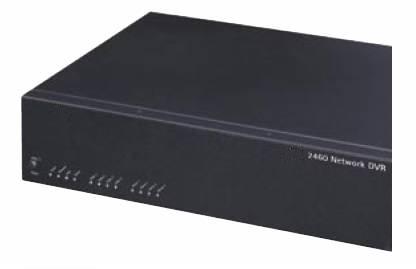
Sophisticated,
flexible yet brilliant in its simplicity, the award winning DVR2460
Network DVR takes digital video recording to a completely new
level of advancement. Connect it directly to a TCP/IP network
and remotely access digital video and system administration tools,
using a standard web browser. Accommodating up to four analog
cameras with or without Pan/Tilt/Zoom, it has its own built-in
web server and is completely self-maintained. No need for tapes,
tangles or expensive maintenance!
Retaining
important video sequences for longer than any other DVR solution,
the DVR2460 offers an almost inexhaustible local recording resource
for security video - using revolutionary APViS™ Prioritized
Video Storage technology*. Used as a single stand-alone system
for a small business, or as an autonomous component within a globally
distributed video surveillance system, the DVR2460 is perfect
for use within large retail chains, franchise operations, or any
business that requires convenient network access to live or recorded
surveillance video.
*Patented
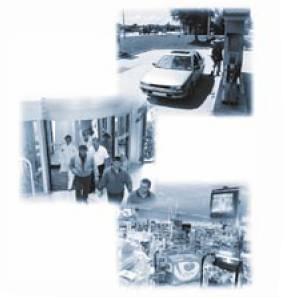 |
|
| Features |
 |
Stores
important video for longer using |
| |
revolutionary
APViS Technology |
 |
Fault
tolerant system with data base |
| |
mirroring
and distributed video storage |
 |
Self-contained
and self-maintained |
| |
system |
 |
Simultaneous
viewing, recording, |
| |
playback,
and administration |
| |
via
web browser |
 |
Support
for Pan/Tilt/Zoom units |
| |
|
| |
|
|
| Innovative
APViS™
Stores
important video for longer
Older
video recordings can contain vital visual evidence. But
when the hard disk in any conventional DVR is full, it is
simply the oldest recordings that are indiscriminately erased
in order to make room for new ones. It's standard FIFO logic:
the First image In is the First one Out. But, is this really
the smartest way of managing modern surveillance video?
Using
innovative APViS technology, the DVR2460 Network DVR makes
more efficient use of valuable disk space to preserve video
recordings for longer. Flexible event management makes it
possible to define up to 100 separate events, combine scheduling
with alarm inputs, and by intelligently using event and
alarm data, it cleverly differentiate between 'important'
and 'less important' video.
Using
these criteria, the DVR2460 is able to store top priority
video sequences at their original recording rate up to four
times longer than any conventional FIFO storage solution
- and up to sixteen times longer using an incrementally
reducing framerate. In practical terms, this can be the
dramatic difference between having the evidence - and not
having it!
Example
|
| The
graph below displays typical storage times for APViS 'Extended'
recording mode versus conventional 'FIFO' storage, based on
the following configuration: |
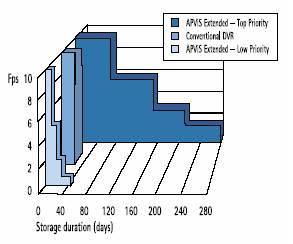 |
 |
Original
recording frame rate = 10 |
| |
fps |
 |
Average
image size = 8kB |
 |
1
x camera |
 |
4
x 40GB IDE HD |
 |
Continuous
low priority recording, |
| |
and priority a single top alarm recording with 30 minute duration |
| |
|
|
Secure
Storage. Secure Video.
In
security applications, consistent quality of the recorded
image is vital. With three different resolutions available
per connected camera, the DVR2460 records in Motion JPEG
format and guarantees consistent high-quality on each and
every image.
The
unique use of database mirroring and distributed video storage
on all available hard disks allows the DVR2460 to tolerate
hard disk failure without losing vital parts of video recordings.
The practical implication of hard disk failure is a relative
reduction in the frame rate of the recordings.
DVR2460
has three levels of user/password protection, with builtin
firewall functionality based on IP filtering for secure
remote system access over TCP/IP networks. |
Flexible
Network Configuration
Stand-alone or components
within globally distributed systems
With
over 90% of archived video recordings often never even looked
at, decentralized video recording avoids unnecessary network
utilization and makes sense when network bandwidth is limited.
A
DVR2460 Network DVR has its own built-in web server and
is securely accessed from any remote geographical location
using Microsoft Internet Explorer.
By
deploying a single DVR2460 in each remote site, organizations
now have the opportunity to build large globally distributed
video storage systems, whereby users can view video and
control Pan/Tilt/Zoom as well as managing recorded material
from anywhere over TCP/IP networks.
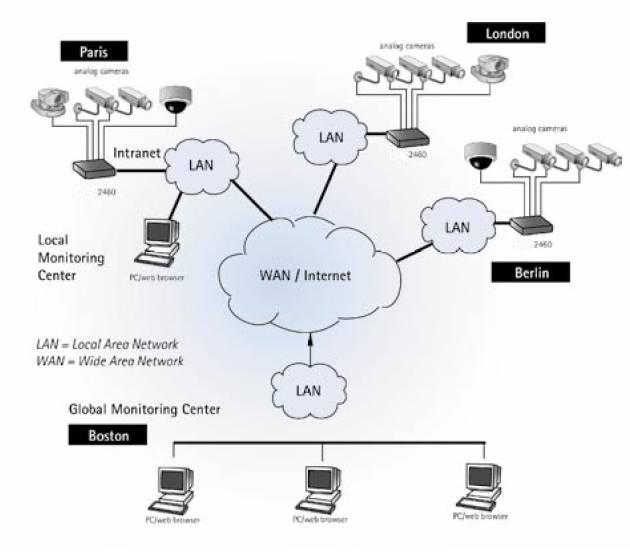
A
globally distributed system comprising several DVR2460 Network
DVRs |
| |
|
| Technical
Specifications |
| |
|
| DVR2460
Network Digital Video Recorder |
| |
|
| General
Features |
|
 |
Simultaneous
live remote viewing, |
| |
recording,
playback and administration via a web browser |
 |
Consistent
high-quality digital |
| |
images
that do not deteriorate with age |
 |
Continuous,
event/alarm, manual |
| |
and
scheduled recording modes |
 |
Snapshots
and AVI extraction to PC hard disk or any preferred digital
media |
 |
Self-maintained
system requires no physical intervention during normal operation |
 |
Self-contained
system requires no additional software components |
 |
Support for Pan/Tilt/Zoom units |
 |
Quad
view display |
 |
User-selectable
settings for frame rate, compression and resolution |
 |
Event
notification via e-mail |
 |
Pre-alarm
buffer and recording duration settings |
| System
Requirements |
 |
Ethernet
network or supported V.90 compatible modem |

|
Internet
Explorer 5.x or higher |
 |
Supports
standard Internet TCP/IP protocols and can be used with: Windows
NT/2000, |
| |
Me,
and XP |
| System |
 |
100baseTX Fast Ethernet or 10baseT Ethernet |
 |
CPU:
ETRAX 100 LX 32 bit RISC processor |
 |
Flash
memory: 4 MB |
 |
RAM:
32 MB |
 |
Based
on Linux version 2.4 operating system |
| Installation |
 |
Physical network connection using
RJ-45 twisted pair cable |
 |
Installs directly to NTSC or
PAL video cameras using BNC connectors |
| Software
Updates |
 |
Flash memory allows central and remote updates over the network,
using FTP over TCP/IP. |
| Front
Panel Control And Indicators |
| LED
Indicators |
 |
4
x video indicators, 4 x alarm active indicators, 1 x power
indicator, 1 x status indicator, |
| |
1
x disk activity indicator and 1 x network activity indicator |
| Push-button
Controls |
 |
1
soft power on/off button |
| Resolution |
 |
QCIF:
176 x 120 (NTSC), 176 x 144 (PAL) |
 |
CIF:
352 x 240 (NTSC), 352 x 288 (PAL) |
 |
4CIF: 704 x 480 (NTSC), 704 x 576 (PAL) |
| Recording
Frame Rate |
 |
1
camera: CIF, normal compression: 30/25 fps (NTSC/PAL) |
 |
4
cameras: CIF, normal compression: 30/25 fps (NTSC/PAL)* |
| |
*Total
number of frames with connecting cameras synchronized |
| Security |
 |
User level password protection |
 |
Built-in firewall functionality based on IP filtering protects
against illicit use from unauthorised |
| |
computers |
| Storage
Capacity |
 |
Up
to 160 GB (4 x max 40 GB HD) |
 |
Storage
duration dependent on image settings |
 |
Recording
availability at CIF resolution, with respect to the available
APViS recording and |
| |
compression
modes, are provided below: |
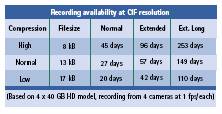 |
| Connections |
| Network
Connector |
| |
RJ-45
connection to 10/100Mbit Ethernet networks |
| Video
Inputs |
| |
4
x composite video inputs with loop/through connector, selectable
75 ohm, Hi Z termination |
| |
Autosensing
for NTSC and PAL |
| |
4
x BNC video loop-through ports |
| I/O |
| |
Single
Terminal Block Connector |
| |
4
x opto-isolated alarm inputs |
| |
1
x output relay |
| Serial
Connector |
| |
9
pin D-SUB RS-232 max 115 Kbps |
| |
9
pin D-SUB RS-232 or RS-485/422 max 115 Kbps, half duplex |
| Power |
| |
115/230V
AC, 50/60 Hz, Max 1A (typically 60W) |
| Operating
Conditions |
| |
Temperature
41-104°F (5-40°C) |
| |
Humidity
20-80% RHG Included |
| Dimensions
and Weight |
| |
Physical
Dimensions: 16.9¡¨ x 12.6¡¨ x 3.9¡¨, 430 x 320 x 100 mm |
| |
Delivered
with brackets for 19¡¨ rack mount |
| |
Weight:
No disks ¡V 15.4 Ibs (7 kg), 2 disks ¡V 18.1 Ibs (8.2 kg),
4 disks ¡V 20.7 Ibs (9.4 kg) |
| Approvals |
| EMC |
| |
 EN55022 Class B, EN55024
EN55022 Class B, EN55024 |
| |
FCC
Class A |
| |
 |
| Safety |
| |
EN60950,
C-UL Listed |
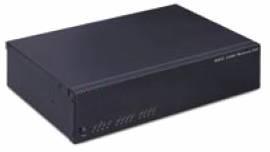
|









